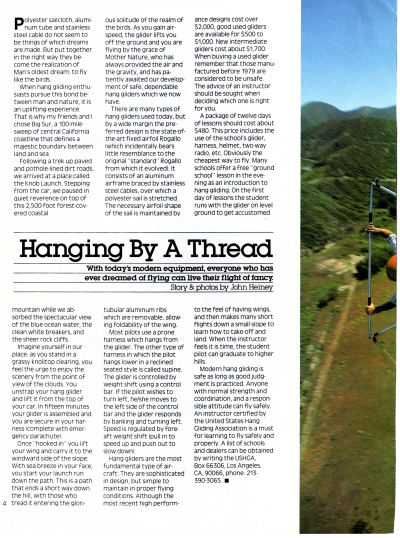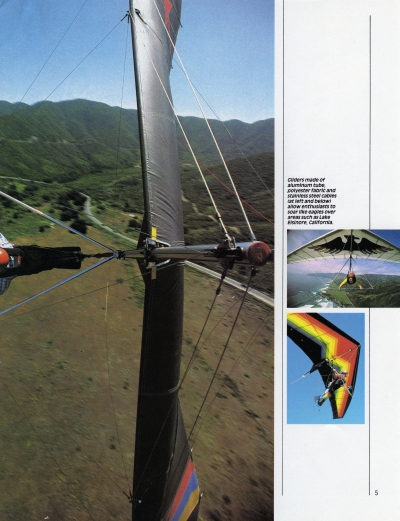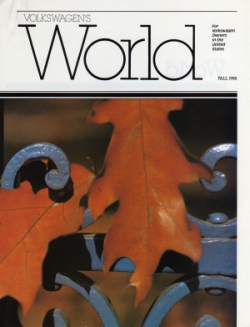 |
 |
 |
 |
Polyester sailcloth, aluminum tubes and stainless steel cable do not seem to be things of which dreams are made. But, put together in the right way they become the realization of Man's oldest dream: to fly like the birds. When hang gliding enthusiasts pursue this bond between man and nature, it is an uplifting experience. That is why my friends and I chose Big Sur, a 100-mile sweep of the central California coastline that defines a majestic boundary between land and sea.
Following a trek up paved and pothole-lined dirt roads, we arrived at a place called the Knob Launch. Stepping from the car, we paused in quiet reverence on top of this 2,500-foot-high forest-covered coastal mountain while we absorbed the spectacular view of the blue ocean water, the clean white breakers, and the sheer rock cliffs.
Imagine yourself in our place: as you stand in a grassy knoll-top clearing, you feel the urge to enjoy the scenery from the point of view of the clouds. You unstrap your hang glider and lift it from the top of your car. In fifteen minutes your glider is assembled and you are secure in your harness (complete with emergency parachute). Once "hooked-in" you lift your wing and carry it to the windward side of the slope.
With sea breeze in your face, you start your launch run down the path. This is a path that ends a short way down the hill, with those who tread it entering the glorious solitude of the realm of the birds.
As you gain airspeed the glider lifts you off the ground and you are flying by the grace of Mother Nature, who has always provided the air, the hills, and the gravity; and has patiently awaited our development of safe dependable hang gliders which we now have.
There are many types of hang gliders used today, but by a wide margin the preferred design is the state-of-the-art fixed airfoil Rogallo (which incidentally bears little resemblance to the original "standard" Rogallo from which it evolved).
It consists of an aluminum airframe braced by stainless steel cables, over which a polyester sail is stretched. The necessary airfoil shape of the sail is maintained by tubular aluminum ribs which are removable, allowing foldability of the wing.
Most pilots use a prone harness which hangs from the glider. The other type of harness in which the pilot hangs lower in a reclined seated style is called supine.
The glider is controlled by weight shift using a control bar. If the pilot wishes to turn left, he/she moves to the left side of the control bar, and the glider responds by banking and turning left. Speed is regulated by foreaft weight shift (pull in to speed up and push out to slow down).
Hang gliders are the most fundamental type of aircraft. They are sophisticated in design, but simple to maintain in proper flying condition. Although the most recent high performance designs cost over $2,000, good used gliders are available for $500 to $1,000.
New intermediate gliders cost about $1,700. When buying a used glider remember that those manufactured before 1979 are considered to be unsafe. You should seek the advice of an instructor when deciding which one is right for you.
A package of twelve days of lessons should cost about $480. This price includes the use of the school's glider, harness, helmet, two-way radio, etc. Obviously hang gliding is the cheapest way to fly. Many schools offer a free "ground school" lesson in the evening as an introduction to hang gliding.
On the first day of lessons the student runs with the glider on level ground to get accustomed to the feel of having wings, and then makes many short flights down a shallow slope to learn how to take-off and land. When the instructor feels it is time the student pilot can graduate to higher hills.
Modern hang gliding is safe as long as we use good judgment. Anyone with the desire to fly, normal strength and coordination, and a responsible attitude can fly safely. An instructor certified by the United States Hang Gliding Association is a must for learning to fly safely and properly.
A list of schools and instructors can be obtained by writing the USHGA Box 66306 Los Angeles CA 90066. phone: 213-390-3065. [address and phone number obsolete]

Originally published in Volkswagen's World Magazine, Fall 1985
Note: Pricing in this article reflects 1985 dollar value. Glider and instruction prices are two to three times higher today. I left the information in the article unchanged for the purpose of historical reference.
The national organization for freeflight is now the United States Hang Gliding and Paragliding Association in Colorado Springs CO. www.ushpa.aero